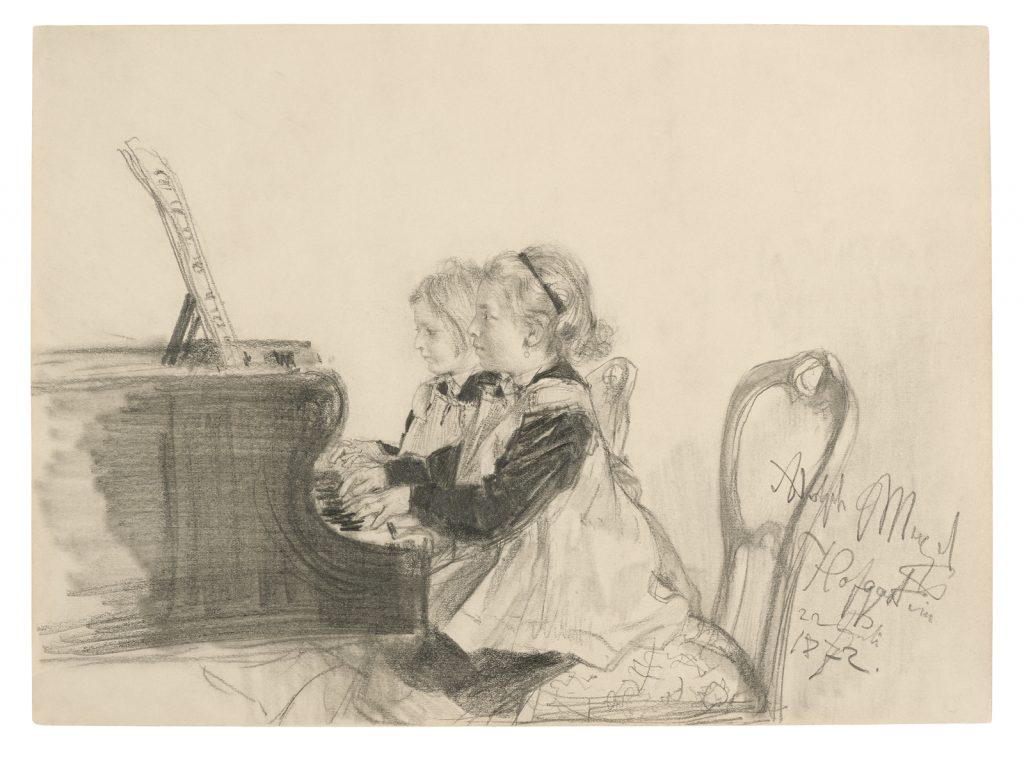Adolph von Menzel
(Breslau 1815 - 1905 Berlin)
Therese and Grete Herrmann at the Piano, 1872
Pencil on paper, 24.5 × 33.6 cm
Signed, inscribed and dated lower right Adolph Menzel / Hofgastein / 22 Juli /1872.
Provenance:
Magnus Herrmann, Berlin (1817-94);
Mathilde Herrmann (née Friedlaender), wife of Magnus Herrmann (1894-1902);
Agathe Herrmann, Berlin (c.1855-c.1930), daughter of Mathilde and Magnus Herrmann1
Private collection, Berlin;
Kunsthandel Thomas le Claire, Hamburg;
Private collection, Germany (since 1997);
Private collection, USA.
Exhibited:
Kunst-Ausstellung zur Ehrung der achtzigjährigen Mitglieder Andreas Achenbach, Adolph Menzel, Julius Schrader im Akademie-Gebäude Unter den Linden 36, Berlin, Königliche Akademie der Künste, 1895, no. 263;
Ausstellung von Werken Adolph von Menzels, Berlin, Königliche National-Galerie, 1905 (2nd edn.), no. 5310;
Eröffnungs-Ausstellung unseres neuen Berliner Hauses, Bellevuestr. 13, Berlin, Galerie Thannhauser, 1927, no. 203;
Hundert Jahre Berliner Kunst im Schaffen des Vereins Berliner Künstler, Berlin, Verein Berliner Künstler, 1929, no. 1024.
Literature:
Agathe Herrmann ‘Wie ich Menzel kannte’, in Moderne Kunst in Meisterholzschnitten, XX, Berlin n.d. (1905), pp. 99-101;
Gisold Lammel (ed.), Exzellenz lassen bitten. Erinnerungen an Adolph Menzel, Leipzig 1992, pp. 249-54, citation after Agathe Herrmann (1905) p. 251, drawing repr. p. 249, epilogue p. 370;
Kurt Karl Eberlein, ‘Hundert Jahre Berliner Kunst’, in Kunst und Künstler, y. 27, H. 9, June 1, 1929, full-page repr. preceding p. 335;
Id., Adolph Menzel und seine Kreise, Dresden and Basel 1993, p. 142, fig. 88 and p. 143;
Luciano Pelizzari, Menzel in Verona: die Italienreisen des großen deutschen Malers des 19. Jahrhunderts, exhib. cat., Ingelheim, Museum Altes Rathaus, Leipzig 2008, p. 277.
Adolph Menzel spent the summers of 1872 to 1874 in Hofgastein. At home in Berlin, he continued work on his major project, the painting Iron-Rolling Mill (Modern Cyclops). After endless weeks taken up with preparatory studies made in the factory at Königshütte, the invitation from the Berlin banker and art collector Magnus Herrmann no doubt came as a welcome distraction. Herrmann was one of the first admirers and patrons of Menzel’s work, and the owner of important paintings such as The Flute Concert and the Departure of King Wilhelm I (both now in the collection of the Nationalgalerie in Berlin). At his behest a studio was created for Menzel in the gardener’s cottage at the Herrmann residence, Villa Carolina.
It is unlikely to be pure happenstance that Agathe, one of the Herrmann siblings and a later owner of the present sheet, recollected this poignant scene in her memoirs (published in 1905): He [Menzel] would go out in wind and weather but one day when there was too heavy a downpour, he came into the music room where my two little sisters were playing Haydn’s ‘Serenade’ together on the piano. ‟Children,ˮ he called out, “I want to draw the candelabra, play something for me while I’m drawing’, and thus he could capture the undisturbed image of their playing in all its naturalness and sketch the picturesque, unique likeness of them with which he later delighted my parents.2
The sheet depicts the two youngest Herrmann daughters, Theresa and Grete seated at the piano on upright, upholstered chairs. It is clear from their expressions and erect positions that they are both engrossed in the music. On a stand in front of them is a music sheet. Menzel conveys their ingenuousness and lack of inhibition with remarkable virtuosity and observes their playing with a kindly, affectionate eye.
Music was an important part of family life at the Villa Carolina. In the evening, the father would make music with his daughters, his son-in-law – the painter Albert Hertel (1843-1912) – and Menzel’s brother-in-law Albert Krigar. Menzel himself did not play an instrument but participated in his own way, with pencil and paper. Along with Therese and Grete, he sketched other members of the family making music, such as Magnus Herrmann on the violin (1874) and Clara Herrmann-Hertel, the eldest Herrmann daughter (1874) at the piano.3
1 The couple had five children – Clara, Agathe (c.1855-c.1930), Siegfried Paul, Therese (b.1863) and Margarethe (b.1864). See Luciano Pelizzari, Menzel in Verona: die Italienreisen des großen deutschen Malers des 19. Jahrhunderts, exhib. cat., Ingelheim, Museum Altes Rathaus, Leipzig 2008, p. 277.
2 Agathe Herrmann ‘Wie ich Menzel kannte’, in Moderne Kunst in Meisterholzschnitten, XX, Berlin n.d., (1905), pp. 99-101.
3 Adolph Menzel, The Banker Magnus Herrmann Playing the Violin, 5 August 1874, charcoal and crayon on paper, 13 x 20.3 cm, private collection.
Adolph Menzel, Clara Herrmann-Hertel at the Piano, 21 June 1874, pencil on paper, 20.8 x 13.2 cm, Berlin, Kupferstichkabinett, Staatliche Museen zu Berlin, inv. SZ Menzel N2551.

